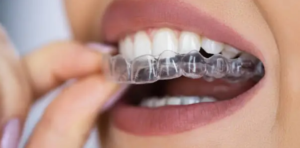Braces and Invisalign have their benefits when it comes to straightening your smile. However, there are several factors to consider before choosing one.
Traditional dental braces are designed to treat crooked teeth, overcrowding, and other orthodontic issues. They consist of metal brackets that run along a wire and can be customised with coloured bands. For more information about Invisalign vs traditional braces Adelaide, click here.
Cost
 If you want to improve your smile, orthodontic treatment may be the right choice. Invisalign and traditional braces offer practical solutions to straighten teeth, but there are some key differences to consider.
If you want to improve your smile, orthodontic treatment may be the right choice. Invisalign and traditional braces offer practical solutions to straighten teeth, but there are some key differences to consider.
However, for best results, Invisalign trays must be worn for 20 – 22 hours daily. You can remove them for special occasions, but it’s important not to forget them, as any deviation from the recommended schedule will affect your treatment time.
If you choose to get Invisalign, it’s worth checking if your private health insurance covers the cost of the treatment. Many policies do provide coverage, although it varies from one provider to another. You can also use tax-free dollars from flexible savings accounts or health savings funds to pay for the costs of Invisalign.
Comfort
Aside from being a more discreet treatment option, Invisalign is more comfortable than traditional braces. The patented Invisalign blend of plastics is softer and has less impact on the mouth’s soft tissues. You will also have fewer follow-up visits as your orthodontist won’t need to tighten your braces manually.
With Invisalign, you can eat whatever you want (except for hard or sticky foods). You can also brush and floss your teeth without worrying about getting food stuck in the wires or brackets of your braces.
However, it’s important to note that both treatments require discipline to wear your aligners as directed. That is why choosing an orthodontist with extensive experience with both treatments is crucial. They’ll be able to help you achieve the best results in the shortest amount of time. They’ll also know how to adjust your treatment plan if necessary.
Ease of Cleaning
Traditional braces apply constant pressure to your teeth to help them reach the desired position. They consist of metal brackets bonded to the outside of your teeth and a thin metal wire that runs from frame to stand.
Patients wearing braces must brush their teeth and clean their wires and brackets twice daily to prevent food particles from getting stuck in the stands and causing inflammation. To avoid staining them, they must also remove their aligners before eating and drinking.
Invisalign trays can be easily removed and reinserted, which makes it easier to maintain good oral hygiene. You can also eat whatever you want, and there are no food restrictions, as is the case with traditional braces. It makes managing your diet and lifestyle easier, which can lead to a quicker treatment time. It is especially beneficial for teenagers and tweens. However, it is essential to remember that your treatment won’t be as effective if you don’t wear your trays for as long as your orthodontist recommends. For more information about Invisalign vs traditional braces Adelaide, click here.
Appearance
Invisalign is clear and virtually invisible so that you won’t have the metal mouth look associated with braces. It can be a significant selling point for adults who may feel self-conscious about their orthodontic treatment. You can also customise your Invisalign with colourful elastic bands to make a statement or to match a specific occasion.
However, you’ll need to remove your aligners when eating and drinking. It can be a hassle, and having a good hygiene routine is essential, as food and drinks can get stuck in your teeth. It is also worth noting that you’ll need to clean your Invisalign trays regularly, and you should ideally rinse them after each meal.
Invisalign is an excellent option for many people. It is effective for correcting bite problems, closing gaps and repositioning teeth. However, it may not be the best solution for more complex dental issues. That is why discussing your options with a specialist Orthodontist is essential.